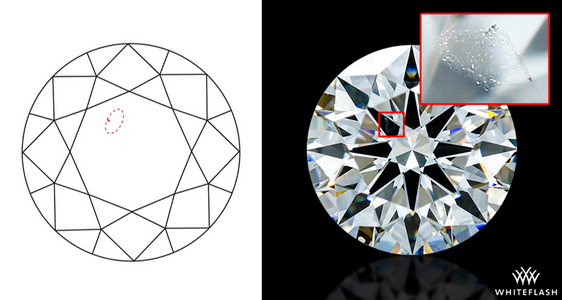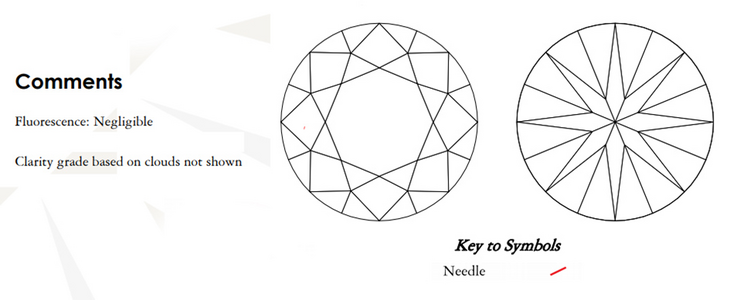- Joined
- Jul 27, 2009
- Messages
- 4,097
The word “cloud” on a diamond report can be somewhat alarming, causing concern that the diamond might be “cloudy”. But the term can be used in a variety of contexts and stated in several different ways on a laboratory report. Some are benign, serving only to identify the diamond like a fingerprint. Others are much more worthy of attention because no gemological laboratory today measures or grades transparency. And many, many diamonds suffer from transparency deficits (cloudiness/milkiness), including both natural and lab grown diamonds.
What is a Diamond Cloud Inclusion?
A cloud inclusion is simply an area of very fine pinpoint inclusions. It can be a very small area or very large one. The pinpoints can be very densely packed or very sparse. A small cloud or even several small clouds can be of little consequence, and like any small inclusion will typically have negligible impact on transparency. But large clouds or a great number of clouds can indeed interfere with the propagation of light through the diamond and thereby reduce its transparency to an extent that negatively impacts the diamond's brilliance.

So how can one tell if and when to be legitimately concerned about this problem? As mentioned, no gemological laboratory currently measures or grades transparency – a failing IMHO. However, they do communicate potential problems in the way they talk about clouds. So learning how to interpret a laboratory report is more involved than simply looking at the 4 C’s.
Reading a GIA Report
The first thing to know is that the grade-setting inclusion is listed first on a laboratory report with a stone plot under Keys to Symbols. (here we will focus on full GIA reports). This is the primary inclusion type in the diamond, and the one most responsible for the clarity grade. So if “cloud” is mentioned first and the clarity grade is low (for example Si2) it is more likely that there could be a transparency issue.
Secondly, it's important to understand that not all inclusions are necessarily plotted - only those necessary to positively identify the stone and support the clarity grade.
And last -but certainly not least - pay attention to the Comments section of the report. This is another place the lab can alert to potential transparency issues. There may be mention of other clouds not shown on the plot. Again, this is more concerning if cloud is the grade setter and the clarity grade is low. It’s another nudge to check transparency carefully.
Understanding “Clouds Not Shown” in Diamond Reports
The comment that should be taken most seriously is “clarity grade based on clouds not shown”. And it essentially superceeds the Keys as primary grade setting inclusion. This is a cautionary note even for diamonds with higher clarity grades, Si1 and VS2 for example. Usually this comment indicates that the cloud or clouds run through the entire stone. This comment in an Si clarity almost always indicates a diamond with compromised transparency. How bad, is a question of the density of the cloud or clouds, but the diamond is very likely to be hazy. Some shoppers are tempted by a diamond that is eye-clean and also has a very clean stone plot, but this can be a mistake as the diamond will be deficient in brilliance and fire. Many that think they have found the ‘unicorn’ have actually found a sleepy stone that only looks great on paper!

A Word about Twinning Wisps
Many shoppers like twinning wisps as an inclusion type since they are difficult or impossible to see with the naked eye. But the same caution should be used in considering diamonds with this common feature. Twinning wisps are a disruption in the carbon lattice and can have the effect of interfering with light propagation through the stone and can also make a diamond hazy if numerous or concentrated enough. Like we saw with clouds, this is more of a concern in lower clarity grades.
”Cloud” may be a scary term while “twinning wisp’ sounds very innocent. And both are usually completely benign in the higher clarity grades. It is the extent of their presence in a diamond that is really the key to their impact on transparency. Understanding how the laboratories communicate this on a diamond report is especially important when buying online. Transparency deficits can be subtle and require a trained eye to assess accurately.
What are your thoughts about Clouds? We’d love to hear your comments or questions!
What is a Diamond Cloud Inclusion?
A cloud inclusion is simply an area of very fine pinpoint inclusions. It can be a very small area or very large one. The pinpoints can be very densely packed or very sparse. A small cloud or even several small clouds can be of little consequence, and like any small inclusion will typically have negligible impact on transparency. But large clouds or a great number of clouds can indeed interfere with the propagation of light through the diamond and thereby reduce its transparency to an extent that negatively impacts the diamond's brilliance.

So how can one tell if and when to be legitimately concerned about this problem? As mentioned, no gemological laboratory currently measures or grades transparency – a failing IMHO. However, they do communicate potential problems in the way they talk about clouds. So learning how to interpret a laboratory report is more involved than simply looking at the 4 C’s.
Reading a GIA Report
The first thing to know is that the grade-setting inclusion is listed first on a laboratory report with a stone plot under Keys to Symbols. (here we will focus on full GIA reports). This is the primary inclusion type in the diamond, and the one most responsible for the clarity grade. So if “cloud” is mentioned first and the clarity grade is low (for example Si2) it is more likely that there could be a transparency issue.
Secondly, it's important to understand that not all inclusions are necessarily plotted - only those necessary to positively identify the stone and support the clarity grade.
And last -but certainly not least - pay attention to the Comments section of the report. This is another place the lab can alert to potential transparency issues. There may be mention of other clouds not shown on the plot. Again, this is more concerning if cloud is the grade setter and the clarity grade is low. It’s another nudge to check transparency carefully.
Understanding “Clouds Not Shown” in Diamond Reports
The comment that should be taken most seriously is “clarity grade based on clouds not shown”. And it essentially superceeds the Keys as primary grade setting inclusion. This is a cautionary note even for diamonds with higher clarity grades, Si1 and VS2 for example. Usually this comment indicates that the cloud or clouds run through the entire stone. This comment in an Si clarity almost always indicates a diamond with compromised transparency. How bad, is a question of the density of the cloud or clouds, but the diamond is very likely to be hazy. Some shoppers are tempted by a diamond that is eye-clean and also has a very clean stone plot, but this can be a mistake as the diamond will be deficient in brilliance and fire. Many that think they have found the ‘unicorn’ have actually found a sleepy stone that only looks great on paper!

A Word about Twinning Wisps
Many shoppers like twinning wisps as an inclusion type since they are difficult or impossible to see with the naked eye. But the same caution should be used in considering diamonds with this common feature. Twinning wisps are a disruption in the carbon lattice and can have the effect of interfering with light propagation through the stone and can also make a diamond hazy if numerous or concentrated enough. Like we saw with clouds, this is more of a concern in lower clarity grades.
”Cloud” may be a scary term while “twinning wisp’ sounds very innocent. And both are usually completely benign in the higher clarity grades. It is the extent of their presence in a diamond that is really the key to their impact on transparency. Understanding how the laboratories communicate this on a diamond report is especially important when buying online. Transparency deficits can be subtle and require a trained eye to assess accurately.
What are your thoughts about Clouds? We’d love to hear your comments or questions!
Last edited:







300x240.png)